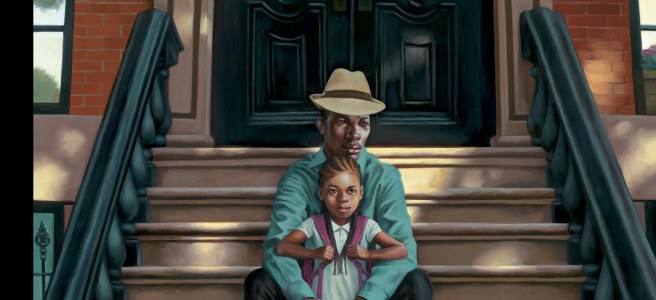
“Generations,” is the front cover of the New Yorker Magazine on October 02, 2017, by Kadir Nelson. The artist was inspired by his time living in New York: “Sitting on the stoop is such a New York thing… Brownstones, stoops, leaves turning: that’s fall in New York, and I was also thinking about all the sweet moments I’ve had with my daughters.” The cover depicts an African American father, and daughter sitting in front of a brownstone house, typical of Harlem and Park Slope in an autumn day. It appears as if they are waiting for a bus to go to school. The child is ready for a new day, while her father is deep in his thought about a day ahead.They are ready for work, school, or for a social fight. One does not know.
Not many New Yorkers actually get to enjoy the scenes of brownstones and stoops. It is a privilege to be able to sit on those stoops, and watch autumn leaves fall. Very few residential areas in New York have those cigar box-like structures. Nelson used to live in the Clinton Hill neighborhood of Brooklyn. The majority of brownstones that I have seen are located in Central Harlem, my current neighborhood. Luckily enough, I get to live in a brownstone, which was renovated in the 1990s.
Erving Goffman once said, when doing fieldwork, “you’ll see more than you’ll ever see again.” That is true for my observation of my neighborhood. When I first moved in very late on a Sunday night, a group of young African American men sitting on the stoop of the house next door, greeted me, their new neighbor. They were curious about whether I am a student, and whether I go to school nearby. The interaction between me and the men could be described as purely civil. They were curious about a young Asian lady who would be their neighbor. I was trying to be nice to them because I hoped that they would play the role of “public characters,” and keep “their eyes on the streets” for me late at night. I was happily engaging in their conversations, and tried to get to know them. I was trying to make my presence known among my housemates, and my neighbors. They seemed to be aware of who was new and who was from the neighborhood.
Originally, I was expecting some hostility that residents of Harlem would display toward newcomers, especially toward someone from a different racial background. However, it has not been the case. My daily interactions with my neighbors, and other residents of Harlem could only be described with one word: “civil.” Every time I need direction, people have been very nice, and they go out of their way to help me. Sometimes people get confused because of my accent; sometimes I get confused because of their accent. Yet for the most part I like my “hood.”
On my daily walk home, I could admire the charm of brownstone houses. Every once in a while, I would listen to jazz music from a close by bar, or to attend a jazz concert at the Schomburg Center. At the end of the day, I was moving into the mecca of African American culture, a place of rich culture and history, and of racial tension. As a researcher, my purest intention is to understand Harlem’s history, and culture.
In fact, my landlord is a jazz musician, whose band would practice, and perform in our backyard. One day, the band practiced in our house in preparation for a gig that weekend. I was lucky enough to came home while they were in section, and just sat on the stoops, and enjoyed their jam. One could never day dream enough with that beautiful sound of Harlem especially in the fall. After an hour, the gentlemen came out to the stoops for a cigarette break, and asked me about my experience teaching at City College. Music, arts, and education could really bring people together. I wish that I could show how happy they were when they learned that I hope I could play a musical instrument to jam with them.
Next semester, I get to teach a class on Urban Sociology, and I cannot wait to tell my students about brownstone houses in Harlem. Currently I am soliciting books, and articles on brownstone houses. The newest book that I have encountered is Down the Up Staircase by Bruce Haynes and Syma Solovitch, a native of Harlem. The book is about three generations of a Harlem family who lives in Sugar Hill area, where City College is located. Beautifully enough the book actually makes the brownstone house to be one of the main characters. Its deterioration is a reflection of the downward mobility that a middle class African American family experienced during the mid-twentieth century. I was wondering whether my students will be able to figure out which house in the neighborhood is depicted in the book. Hopefully I will be able to show my students how beautiful Harlem is, and what a privilege they have to be able to study urban sociology right there.
After all, I love my hood!

